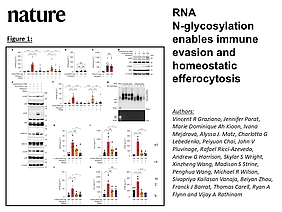New publication by the Carell lab on how RNA N-glycosylation enables immune evasion and homeostatic efferocytosis
Graziano VR, Porat J, Ah Kioon MD, Mejdrová I, Matz AJ, Lebedenko CG, Chai P, Pluvinage JV, Ricci-Azevedo R, Harrison AG, Wright SS, Wang X, Strine MS, Wang P, Wilson MR, Vanaja SK, Zhou B, Barrat FJ, Carell T, Flynn RA, Rathinam VA (2025) RNA N-glycosylation enables immune evasion and homeostatic efferocytosis. Nature Link
Abstract:
Glycosylation is central to the localization and function of biomolecules1. We recently discovered that small RNAs undergo N-glycosylation2 at the modified RNA base 3-(3-amino-3-carboxypropyl) uridine (acp3U)3. However, the functional significance of N-glycosylation of RNAs is unknown. Here we show that the N-glycans on glycoRNAs prevent innate immune sensing of endogenous small RNAs. We found that de-N-glycosylation of cell-culture-derived and circulating human and mouse glycoRNA elicited potent inflammatory responses including the production of type I interferons in a Toll-like receptor 3- and Toll-like receptor 7-dependent manner. Furthermore, we show that N-glycans on cell surface RNAs prevent apoptotic cells from triggering endosomal RNA sensors in efferocytes, thus facilitating the non-inflammatory clearance of dead cells. Mechanistically, N-glycans conceal the hypermodified uracil base acp3U, which we identified as immunostimulatory when exposed in RNA. Consistent with this, genetic deletion of an enzyme (DTWD2) that synthesizes acp3U abrogated innate immune activation by de-N-glycosylated small RNAs and apoptotic cells. Furthermore, synthetic acp3U-containing RNAs are sufficient to trigger innate immune responses. Thus, our study has uncovered a natural mechanism by which N-glycans block RNAs from inducing acp3U-dependent innate immune activation, demonstrating how glycoRNAs exist on the cell surface and in the endosomal network without inducing autoinflammatory responses.
Read the full paper here: https://www.nature.com/articles/s41586-025-09310-6

